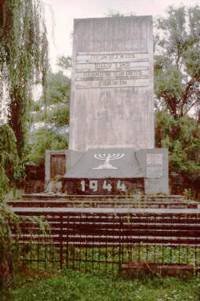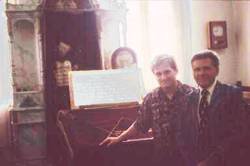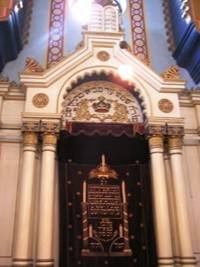 of one of the most intact peasant cultures of Europe. It was our base for the second part of our visit to Romania.
of one of the most intact peasant cultures of Europe. It was our base for the second part of our visit to Romania. Another morning, as we were heading out of town to visit monasteries and villages in the countryside, Alex stopped downtown at a closed synagogue. I thought it might be a good time to try out my most ambitious line of Romanian, so I asked Alex, «Onde pot gasi un rabin care vorbeste englezeste?» (Where can I find a rabbi who speaks English?) I was goofing. I learned it as a goof, and I didn’t expect it to be a useful phrase. But it was. Alex disappeared. When he came back in a few minutes, he beckoned me to follow him to the side of a building and into an office, where he
Another morning, as we were heading out of town to visit monasteries and villages in the countryside, Alex stopped downtown at a closed synagogue. I thought it might be a good time to try out my most ambitious line of Romanian, so I asked Alex, «Onde pot gasi un rabin care vorbeste englezeste?» (Where can I find a rabbi who speaks English?) I was goofing. I learned it as a goof, and I didn’t expect it to be a useful phrase. But it was. Alex disappeared. When he came back in a few minutes, he beckoned me to follow him to the side of a building and into an office, where he but his English wasn’t bad. We went over to the synagogue. He explained that it had been a Sephardic Synagogue, while most of the Romanian Jews were Ashkenazi. A small room was being used for weekly services; the synagogue proper was undergoing serious restoration. Hari’s son Sorin, an excellent English speaker, joined us. From the two of them I got the following outline of what had happened to the Jews of Sighet.
but his English wasn’t bad. We went over to the synagogue. He explained that it had been a Sephardic Synagogue, while most of the Romanian Jews were Ashkenazi. A small room was being used for weekly services; the synagogue proper was undergoing serious restoration. Hari’s son Sorin, an excellent English speaker, joined us. From the two of them I got the following outline of what had happened to the Jews of Sighet.
In 1944, all the Jews were shipped to Aushwitz and other concentration camps. Most perished; some came back after the war. Of those that resettled in the area, almost all emigrated to Israel. Romanian Jews make up the second largest contingent of the Israeli population. Jews were pressured to emigrate; during the Ceausescu era, Israel paid Romania $50 for every Jew who moved to Israel.
 Today there are about 100 Jews in Sighet. There are also Gypsy, Hungarian and Ukranian minorities. Everyone gets along, Hari told me.
Today there are about 100 Jews in Sighet. There are also Gypsy, Hungarian and Ukranian minorities. Everyone gets along, Hari told me.
«ARE WE JEWISH?»
I remember asking my parents that. I must have been 14. It wasn’t the naive question of a kid. When I was a kid I knew we were Jewish. It was the thoughtful question of a teenager. I had been to friends’ bar mitzvahs…I knew that there was a big Jewish tradition that we had nothing to do with. No bar mitzvahs, no synagogue visits, even the meager observations we used to have for Passover and Hanukkah had disappeared from our lives. So why are we Jews?
Because, they told me, when they come to round up the Jews, they’ll take us, too. The Holocaust makes us Jews.
I can’t say I found that argument totally convincing, and I continued throughout my life as an ambivalent Jew. When people ask me «Are you Jewish?» I don’t really know how to answer.
I didn’t expect this to be an issue as I planned my Romania trip. On my initial raid on the downtown library for research materials, I avoided everything about «the Holocaust in Romania.» What I wanted at first was stuff about the Roman conquest, but I soon got hooked on the story of Ceausescu and the 1989 revolution.
And even though my mother was born in a refugee camp in what was then Romania (now the Republic of Moldova), a refugee from the anti-Semitic pogroms of the Ukraine, I didn’t have the sense that I was getting back to my own personal roots.
I REMEMBER, ON MY first trip to Mexico City, seeing Diego Rivera’s mural of La Gran Tenochtitlan, the pre-conquest city. It was a sudden opening onto a vast historical vista I had not yet seen. I had a similar experience in the Hebrew Cemetery at Sighet. A part of the past came into focus for me.
It’s not that I haven’t thought about the Holocaust; of course I have. I remember first learning about it at the age of 10, and since then, Holocaust-consciousness has permeated my thought, values and sensibilities. I didn’t think there would be anything left to think or feel about it, even in the center of it. But there was.
I don’t yet know how to describe it. I’m not done thinking about it, and I have to go back and check out those books I passed up before the trip. But I can tell you this:
I never felt more Jewish than among the neglected and overgrown graves at the Sighet Cemetery.
Fuente: The Dagger
Sephardim in Eastern Europe. The Sephardi Synagogue in Sighetu, Rumania


My good friend Ian Pomerantz directed me to this series of great photos of the Synagogue in Sighetu Marmatiei, Romania. The edifice was built between 1900 and 1904 by the Sephardic community in the city and was frequented by both the Sephardi and Ashkenazi communities of Sighetu.
It is one of the only remaining examples of a completely intact Romanian Sephardi esnoga with full Moorish architecture from the mid 19th century.
Joel Hahistorion
Fuente: Jewish History Channel
 eSefarad Noticias del Mundo Sefaradi
eSefarad Noticias del Mundo Sefaradi


Thanks for the pictures.I’ll use them in the family tree.
thanks for the pictures of Sighet synagogue . I’ll use them for the family tree.
Margo
The Sephardic community of Romania has been worshipping in the area since the 1550s. The Sephardic building in its current form was fully completed in 1904, only 8 years before the outbreak of the First Balkan War.
Thank you for the article!
We will be in Maramures for the month of July, and would love to go to the shul. Do you have contact details for Hari Markus?
With thanks
Our family was from Dolha which we believe was in the area. Would they have gone to Sighetu Synagogue? We’re talking about the period of 1903-1908.
Dolha was the hungarian name of the village. It is located in another Region, neighbouring Maramaros. The Region of Dolha was named in Hungarian «Karpatalja». This is now part of Ukraine, between the Carpathians and the preset hungarian border. The region capital was Ungvar, i suppose You should start searching there first. Ungvar had also a significant jewish community.
My father, Dr. Armin Gutman, born in Sighet in 1903, served briefly as president of Sighet’s Jewish community after the war. He practiced medicine in Romania, France, Israel and the U.S. He died in 1987 in New York and is buried at the New Montefiore cemetery on Long Island.
W. E. Gutman
I am looking for information about my grandmother who borned in Maramure-Sighet. Her name was Elena Pasternak/Wiesel. She was Eli Wiesel causin. She left with her family to Argentina before WWI but we never found any record of her in Romania. Any of you that knows her family or relatives is welcome to contact me alberto.blank@gmail.com
Thanks!!
Dear Joel Hahistorion,
i could provide a drawing of the old, «great» Synagogue of Maramarossziget. If interested, please contact me.
Moreover, if you allow me, I would like make some corrections regarding some historical events, dates mentioned in your article.
With regards.
Dear Istvan Takacs, would you have any info or contact of the Rabbi in Maramarossziget? Trying to find my family relations who were born there. Please email me to: budapest28@optusnet.com.au Thank you!
I am trying to trace Nandor (Nakhum) Markowisz (Markovits? Sometimes he is listed under wife’s name (Josef) of Maramarossziget, birth listed as 1873 or 1883, died in Auschwitz 1944. his was was Yente (1888). Thank you very much! dergrossemac7@gmail.com
I think there’s a misunderstanding here. In this region (northern Romania and Subcarpathian Ukraine), «Sephardic» meant Hasidic, because the Lurianic Hasidic liturgy was based in the Sephardic liturgy. I’m sure there were some Jews of Sephardic heritage in Sighet, but this synagogue was simply the Hasidic one.